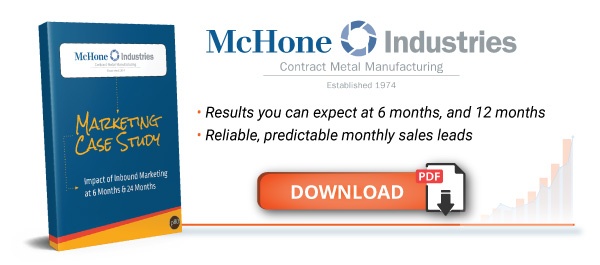Inbound Marketing Blog
for Manufacturers and Healthcare Companies
Is Your B2B SaaS Marketing Budget Giving You a Chance?

For B2B SaaS marketing companies, the stakes are higher.
Most B2C companies (clothing retailers, auto insurance providers, etc.) rely on hundreds or thousands of annual transactions to make their money. But the job of a B2B or SaaS salesperson often hinges on a few five-to-seven-figure sales each year.
Why? B2B SaaS products and services are usually with the customers for a longer time than B2C customers. For example, if an entire company were to purchase a software and integrate it into their daily business activities, it would require company-wide efforts and several weeks of planning -- not to mention, a lot of money.
As a result, businesses typically stick with one particular software for an extended period of time -- even if they’re unhappy with it This creates a challenge for SaaS marketing agencies and sales teams -- you know your product is better than the competition’s, but how do you start that conversation with a lead?
For SaaS marketing firms, knowing how to develop a successful budget and understanding where to allocate resources can be a struggle. Often, SaaS companies put all of their marketing efforts/budgets in one basket -- they spend their budgets entirely on customer acquisition.
Because of the years-long life span of SaaS products, it’s crucial to stand out from competitors. Spending all resources on customer acquisition will not set you apart from others, but knowing how to properly allocate marketing resources will.
B2B SaaS Marketing Consumes Company Budgets: A Common Misconception
Is your SaaS marketing strategy and budget not doing what you’d hoped it would? Don’t be discouraged -- it’s fixable.
Because of the nature of the SaaS industry, SaaS companies are under constant pressure to acquire recurring revenue. With customer acquisition comes a cost. SaaS companies seek to make back the money they spent on acquiring these customers before they find themselves in a deficit. As a result, their main concern is growing at a quick speed, while paying off the money they’ve spent.
To pay off the money spent on customer acquisition, the company must have a strong SaaS product marketing strategy. Let’s take a look at six major, industry-leading SaaS companies and what they spend on marketing efforts:
- Salesforce: spends close to 53% of its revenue on sales and marketing efforts
- Constant Contact: spends close to 38% on sales and marketing efforts
- Marketo: spends close to 67% on sales and marketing efforts
- Manhattan Associates: spends as little as 11% on sales and marketing efforts
- Tableau: spends over 53% on sales and marketing efforts
As depicted by these statistics, marketing budgets vary wildly by company. Your company’s annual spend on sales and marketing will depend on your products, services, and talents of your team. Marketing budgets will vary, but a safe estimate of marketing and sales spend should be anywhere from 10-40% of your annual recurring revenue (ARR).
When adjusting your SaaS marketing strategy and budget, start off slow and see what works for you. Moving full steam ahead on a drastic budget change can be harmful to your company’s revenue stream. Trial and error will help you learn best and make adjustments where necessary.
Inbound Marketing Saves Money
Did you know that inbound marketing can save your SaaS company money?
SaaS companies must generate enough revenue, as quickly as possible, to offset the cost of customer acquisition. While inbound marketing takes 12 months or so to gain momentum, its comparatively low cost can consolidate your budget until the magic starts to happen.
Inbound marketing efforts average $135 per lead, compared to $332 per lead with outbound marketing. Leads can be generated through:
Incorporating inbound marketing into your SaaS marketing budget may just be the best thing your company ever does to increase revenue. For example, by establishing a blog and posting regularly, you can identify yourself as an industry expert and thought leader. Blogs can create up to 60% more visitors and generate more than twice as many leads as companies without a blog.
Most of the best SaaS companies have blogs. Customers are more likely to trust your company and product/service when they see proof of your knowledge level.
Inbound marketing compounds itself over time. As you start putting more effort into SEO and blogging, your business will start ranking higher in Google search results. Over time, your company will begin ranking more frequently and in a higher position without having to do much at all. Inbound marketing is a great equalizer for small-to-mid sized budgets because it doesn’t cost an arm and a leg to make great content!
Get Started on Your New SaaS Marketing Budget … Today!
Creating a rock-solid SaaS marketing budget that allows for steady content creation will help your company succeed in the long run. Although inbound marketing efforts don’t produce immediate results, your company will benefit in the long term and be able to compete with the “big guys” on a level field.
Keep in mind: Inbound marketing is just one piece of the puzzle. Your customer acquisition costs will be lower, but that does not mean you can slash your budget. The combination of inbound marketing and traditional SaaS marketing strategies will help take your company to new levels.
To learn more, see a real-life case study:
Our Blogs, Direct to Your Inbox!
How to Audit your Online Marketing
If you are executing digital marketing, congratulations! You are most likely already one step ahead of your competition, and making strides to meaningfully connect with prospects online. But, how do you know if you’re seeing continual success year over year, and improving your metrics?
Without the tools in place to analyze and benchmark your efforts, it is impossible to scale your online marketing and ensure continuous success.


